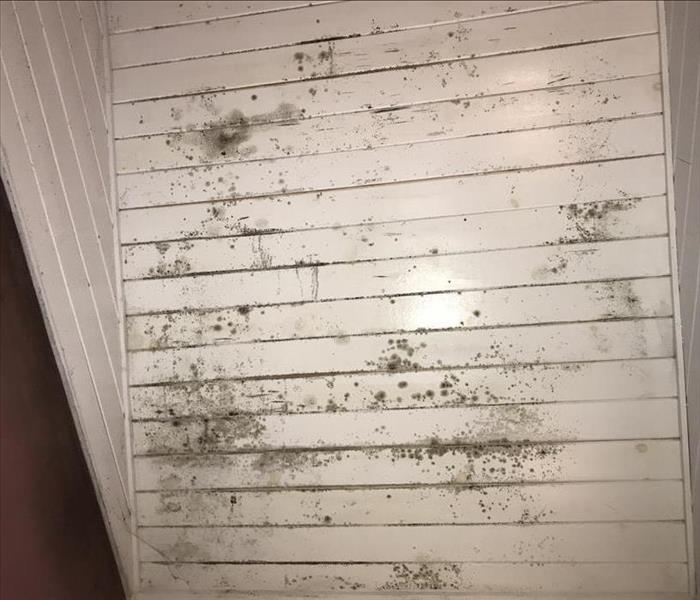What Homeowners Need to Know About Mold
2/19/2018 (Permalink)
Many homeowners know only one thing about mold: get rid of it. But with stories and false information floating around on the Internet, there are many misconceptions that often exacerbate problems or create unnecessary fear. In the following sections, you will find general information that every homeowner should know when it comes to dealing with mold.
What is Mold?
Mold is a variety of fungus that grows and spreads from spores. These spores are so small and light that they can be picked up and travel by air. In fact, mold spores travel so easily that they are found virtually everywhere—indoors and outdoors. (Yes, mold is always present in your home.) When the spores find a suitable home, they grow and spread, often consuming the surfaces they land on. This is when mold really becomes a problem.
How Do I Know if I Have Mold?
It’s difficult to take care of mold if you don’t know that you actually have a problem. While you don’t necessarily have to be an expert to identify any growth, knowing some of the telltale signs might help you notice a problem before it’s out of control.
You can see it. This isn’t always the case, but the most obvious sign you have mold growth is if you can see it. You might expect to see greenish/blackish patches or slimy areas, but sometimes mold will appear like specks of dirt or soot. Regardless of appearance, it should be addressed immediately.
You smell it. The second-most obvious sign (and the one you’ll most likely encounter) is a musty odor. Even if you don’t necessarily see any, musty smells are almost always accompanied by mold growth, so be sure to thoroughly inspect your home if you notice the odor!
You’ve had a leak/water damage. Moisture is an essential ingredient for mold growth, so excess moisture in your home is a good indication that you probably have a problem. If you suffer any water damage, be sure to regularly inspect your home for signs of growth. In ideal conditions (generally in a lab), mold growth can start within 48 to 72 hours; in many cases, it will be present after a couple of weeks or more.
Mold is Growing in My Home. Help!
If you suspect that mold really is growing in your home, then it’s time to take action. Because mold can cause negative health effects and damage the surfaces it grows on, it’s best to respond immediately to minimize effects. Depending on whether or not you can confirm the growth, you can take a few different actions.
You can visually confirm mold growth. If you can actually see mold growth, then you already know you have a problem. Instead of spending money on testing, you can go ahead and call a mold remediation company. They will address moisture issues, treat the growth, and advise you on ways to prevent future growth.
You cannot confirm you have mold growth. When you cannot visually confirm you have a mold issue, it’s best to call in a professional mold inspector. An inspector will collect samples and provide a report that compiles their findings. If they confirm you have mold growth but think it is small enough to handle yourself, they may offer advice. If it is large enough, they will refer you to a mold remediation company.
NOTE: Do not use take-home testing kits. They are largely unreliable and will likely confirm you have spores (remember, spores are everywhere) but not actual growth. If you want to test for actual mold growth, call a reliable mold inspector.
How do I Prevent Mold Growth?
Whether you just had mold growth remediated or you have never had an issue to begin with, you probably want to know what you can do to prevent it from happening in the future. Here are a few steps to keep your homes mold-resistant:
Control your home’s humidity. As we’ve already said, moisture is a key ingredient in mold growth, so it makes sense that you want to keep your home’s humidity low. According to the EPA, you should keep levels below 60% (though 30-50% is ideal), which you can monitor with a moisture meter.
The simplest way to lower humidity is to constantly run fans and/or your HVAC system to let the air circulate. Leaving doors between rooms open will also help with circulation.
Dry wet areas immediately. If you have water damage or condensation builds on susceptible surfaces, you should attempt to dry them immediately. This will reduce or eliminate the moisture mold needs and prevent it from growing. Depending on the extent of the water damage, you might have better results with a professional water damage restoration company who has the capabilities to locate and dry hidden moisture.
Clean and dust regularly. Sometimes mold can appear to grow on inorganic substances like glass and aluminum. Since it cannot feed on those structures, it eats dust, which is organic. If you clean and dust on a regular basis, you can deprive mold of the food it needs to grow.
Don’t Let Mold Stress You Out
Despite the many horror stories people like to share online, mold is a natural occurrence that lives around us all the time. As long as you address any issues quickly and appropriately, you can prevent or eliminate mold growth before it becomes a major problem.
If you are still uncertain or need professional help, contact a mold inspector or a mold remediation company. Either one will get you started on the process and help you make it “Like it never even happened.”






 24/7 Emergency Service
24/7 Emergency Service
